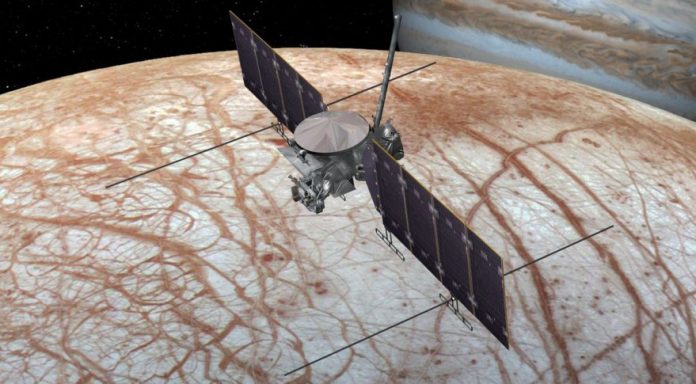NASA’s plan to explore Europa has taken a major step forward, with its mission completing a major instrument review.
NASA said the Europa multiple-flyby mission, often called Europa Clipper, passed a review called Key Decision Point B (KDP-B) Feb. 15. The review allows the mission to enter into a preliminary design phase called Phase B. That phase will formally begin Feb. 27 and run through September 2018.
“This is supremely great news,” said Curt Niebur, the program scientists for the mission at NASA Headquarters, in a Feb. 22 presentation at a meeting of the Outer Planets Assessment Group (OPAG) in Atlanta. “It was an extremely successful KDP-B.”
Niebur said that the review did highlight the need for the mission carefully watch its mass and power levels as it goes into a more detailed level of design work. “We’ve been generous in the allocations for these thus far,” he said. “But we’re now to the point where things are locking down, and we must very carefully manage and track those resources.”
The review also recommended that the project develop a “descope” plan to remove instruments or other capabilities should there be issues with the spacecraft’s mass and power, or its costs. “It is definitely NASA’s full intent to fly the Clipper mission as it currently exists, and with the payload we competitively selected,” he said. “But we’ve got to be ready to curb resource growth if and when it occurs.”
NASA has not yet specified a cost or schedule for the mission, which are typically formally defined at the next major review, Key Decision Point C. NASA’s release about the KDP-B review said the mission is planned for launch only “in the 2020s,” although report language in recent appropriations bills funding NASA have directed the agency to launch the mission by 2022.
That schedule has been set primarily by Rep. John Culberson (R-Texas), chairman of the House appropriations subcommittee that funds NASA and a staunch advocate for Europa exploration. He has allocated money the Europa mission at levels well above NASA’s requests, in the belief that Clipper or a later lander mission could discover evidence of life on the moon, which has an ocean of liquid water beneath its icy surface.
“There’s almost certain to be life in that ocean,” Culberson said in a Feb. 7 speech at a Space Transportation Association luncheon here. “I’m convinced that that mission will result in the discovery of life in that ocean.”
Another question is what launch vehicle will be used for Europa Clipper. The Space Launch System would send the spacecraft on a direct trajectory to Jupiter, allowing it to reach the planet less than three years after launch. “We’re keeping the options open right now,” Niebur said at the OPAG meeting, noting it is also compatible with the Delta 4 Heavy and possibly other vehicles through the use of gravity assists.
“In the big view of things, it doesn’t hurt us to keep launch vehicle options open,” he said. “But the time is coming when we need to narrow that range down.”
There is no similar choice for the proposed lander mission, which will be far heavier than Clipper given the propellant it has to carry to be able to enter orbit around and then land on the surface of Europa. “It’s about 13,000 kilograms wet,” he said. “As of now, SLS is the only vehicle with the performance to launch it.”
The lander mission could fly within just a couple years of Clipper, carrying a suite of instruments to search for direct and indirect evidence of life on Europa. A report by a science definition team for the proposed lander, released earlier this month, identified the science goals for the mission and proposed instruments for the lander that can fit within current mass and power requirements.
The lander is designed to operate for only about 20 days on the surface because of the strong radiation environment. That timeline, and mass and power constraints, are actually an improvement over earlier concepts. Two years ago, a proposed lander had only a 10-day lifetime and 25 kilograms of science payload, said Kevin Hand of the Jet Propulsion Laboratory, one of the leaders of the science definition team, at the OPAG meeting. “The engineering team worked very closely with the science definition team,” he said, “and essentially doubled and almost tripled our baseline mission concept.”
The cost of the lander mission is not yet known, given the mission’s early stage of development, but Niebur defended the approach to launch it on the heels of Clipper rather than waiting until after the end of the Clipper mission to start work on it. Following the traditional “stepwise exploration path,” he said, would delay the mission by at least a decade, if not longer.
“If we wait for the next mission to map it, like we’ve done at Mars, and find multiple landing sites and feed that data back to Earth, and then start designing a landing system, the timestep between our missions is going to be measured in decades,” he said. “If we follow that path for the outer solar system, none of us will ever see the surface.”















